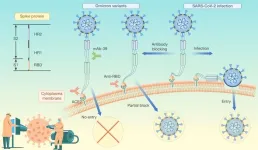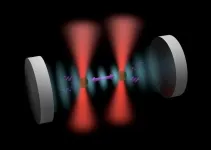A protective human monoclonal antibody targeting a conserved site of spike glycoprotein of SARS-CoV-2 Omicron variants
2024-03-01
(Press-News.org) The ongoing COVID-19 pandemic caused by SARS-CoV-2 has caused serious damage to public health and the global economy, and one strategy to combat COVID-19 has been the development of broadly neutralizing antibodies for prophylactic and therapeutic use. The most emergency-use authorized (EUA) therapeutic monoclonal antibodies, are more likely to lose their neutralizing activities as the viral epitopes (e.g. the receptor-binding domain, RBD) within spike protein of SARS-CoV-2 they target are more prone to mutate. By contrast, the S2 subunit of spike protein, has a much lower frequency of mutation than the RBD and exhibits a high degree of homology among human SARS-like CoVs. As such, developing antibodies targeting the more conserved S2 epitopes are able to exert an incredibly broad neutralization spectrum against SARS-like CoV viruses.
This study is led by Dr. Suping Zhang (Shenzhen University), Dr. Zhenhong Lin (Chongqing University), and Dr Lanfeng Wang (Shanghai Institute of Immunity and Infection, Chinese Academy of Sciences). They isolated one neutralizing mAb, called mAb-39, against SARS-CoV-2 and its variants from convalescent adult. This mAb exhibited good potency in neutralization SARS-CoV2 original strain, previous and current circulating Omicron variants (e.g. Omicron BA.1, BA.2.86, BA.4, BA.5, EG.5.1) in a cell-based assay.
This antibody binds to a highly conserved new epitope on the glycoprotein from SARS-CoV2. “This is very exciting!” Dr. Hang Su says, “The good activity and highly conserved epitope of this antibody suggested its potential for clinical translation”.
The team found the mAb-39 greatly improved the neutralizing activity of anti-RBD antibody, the same type of EUA therapeutic monoclonal antibodies, against the highly neutralization-resistant Omicron variants. The study also extended the knowledge to the neutralizing and protective epitopes of SARS-CoV-2.
See the article:
A human monoclonal antibody neutralizes SARS-CoV-2 omicron variants by targeting the upstream region of spike protein HR2 motif
Doi: 10.1016/j.hlife.2023.09.003
END
[Attachments] See images for this press release:

ELSE PRESS RELEASES FROM THIS DATE:
2024-03-01
Researchers have discovered how “leaky” mitochondria – the powerhouses of our cells – can drive harmful inflammation responsible for diseases such as lupus and rheumatoid arthritis. Scientists may be able to leverage the findings to develop better treatments for those diseases, improve our ability to fight off viruses and even slow aging.
The new discovery reveals how genetic material can escape from our cellular batteries, known as mitochondria, and prompt the body to launch a damaging immune response. By developing therapies to target this process, doctors may one day be able to stop the harmful inflammation ...
2024-03-01
To find out how planetary systems such as our Solar System form, an international research team including scientists from the University of Cologne studied a stellar nursery, the Orion Nebula, using the James Webb Space Telescope (JWST). By observing a protoplanetary disc named d203-506, they discovered the key role massive stars play in the formation of planetary systems that are less than a million years old. The study, led by Dr Olivier Berné from the National Centre for Scientific Research (CNRS) ...
2024-03-01
A research paper by scientists at Bournemouth University proposed a randomized pilot trial, which aimed to determine the effect of an intervention where outdoor walking distance is used as a goal to increase daily activity of older adults using a commercial activity monitor at 3 to 6 months post total hip replacement (THR).
The new research paper, published on Nov. 30 in the journal Cyborg and Bionic Systems, indicated the participants in the intervention group had higher activity levels after THR, compared to those in the control group. The Cohen’s effect ...
2024-03-01
Zinc-air batteries are an inexpensive, powerful battery alternative that can be used on the small scale to power electronics or on the large scale for electric vehicles or energy storage. These batteries work when oxygen from the air oxidizes zinc, but the difficulty in oxygen activation which degrades battery performance has prevented their wide commercial adoption.
Information presented in a paper published in Carbon Future on 19 January shows how fullerene- metalloporphyrin derived carbon materials as catalysts can improve the performance and stability of zinc-air batteries.
“The sluggish kinetic characteristics caused by the difficulty ...
2024-03-01
Highlights:
A chemical called Bisphenol A (BPA) is used to make many durable plastics and resins.
Previous studies suggest high BPA exposure can increase health risks and change gut microbiome structure.
Researchers investigated links between BPA exposure, obesity and the gut microbiome.
The study found that normal-weight children had more unique bacteria taxa, which may help degrade BPA.
The findings may help point to microbial strains that neutralize BPA in the gut.
Washington, D.C. — March 1, 2024 — A synthetic chemical called Bisphenol A, or BPA, is widely used in the production of durable plastic products including eyewear, ...
2024-03-01
Community leaders and administrators now have a more powerful tool for understanding their communities’ economic strengths and vulnerabilities, thanks to the newly enhanced and cleverly monikered National Economic Resilience Data Explorer (NERDE). The online data portal’s enhanced second edition makes it easier for users to create economic development plans, improve resilience and apply for economic assistance and grants.
NERDE first launched as a partnership between the U.S. Department of Energy’s (DOE) Argonne National ...
2024-03-01
The most recent COVID-19 booster shot reduces adults’ risk of moderate or severe COVID by more than half, according to a new nationwide data study from September 2023 through January 2024, a period of JN.1 variant dominance.
The new study is one of the first to evaluate protection provided by the updated shot against COVID-19-associated emergency department and urgent care visits (markers for moderate disease) and against hospitalizations (a marker for severe disease), in individuals 18 and older, due to JN.1, the most ...
2024-03-01
Mendelian randomization, a powerful tool in medical research, helps us understand whether certain factors truly cause disease. This technique uses genetic variations as "natural experiments" to reveal cause-and-effect relationships. However, choosing the proper genetic variations is crucial for accurate results.
Think of a train network where the genetic variation is the starting point, the exposure is a station, and the disease is the destination. The train must pass through the exposure station en route to the disease. This represents the critical assumption of Mendelian randomization: ...
2024-03-01
Penn Engineers have developed a new means of targeting the lungs with lipid nanoparticles (LNPs), the miniscule capsules used by the Moderna and Pfizer-BioNTech COVID-19 vaccines to deliver mRNA, opening the door to novel treatments for pulmonary diseases like cystic fibrosis.
In a paper in Nature Communications, Michael J. Mitchell, Associate Professor in the Department of Bioengineering, demonstrates a new method for efficiently determining which LNPs are likely to bind to the lungs, rather than the liver. “The way the liver is designed,” says Mitchell, “LNPs tend to filter into hepatic cells, and struggle ...
2024-03-01
The question of where the boundary between classical and quantum physics lies is one of the longest-standing pursuits of modern scientific research and in new research published today, scientists demonstrate a novel platform that could help us find an answer.
The laws of quantum physics govern the behaviour of particles at miniscule scales, leading to phenomena such as quantum entanglement, where the properties of entangled particles become inextricably linked in ways that cannot be explained by classical physics.
Research in quantum physics ...
LAST 30 PRESS RELEASES:
[Press-News.org] A protective human monoclonal antibody targeting a conserved site of spike glycoprotein of SARS-CoV-2 Omicron variants








